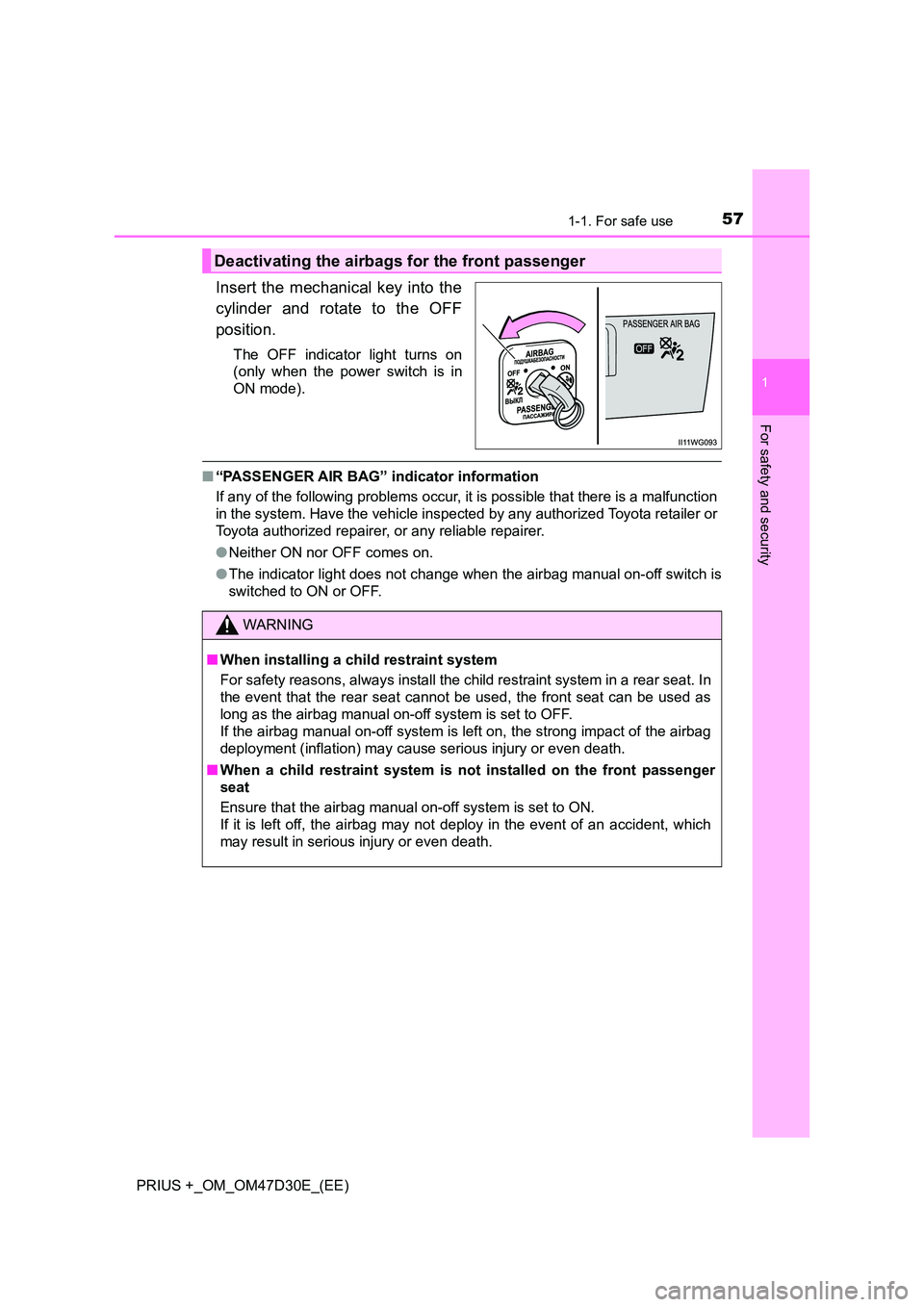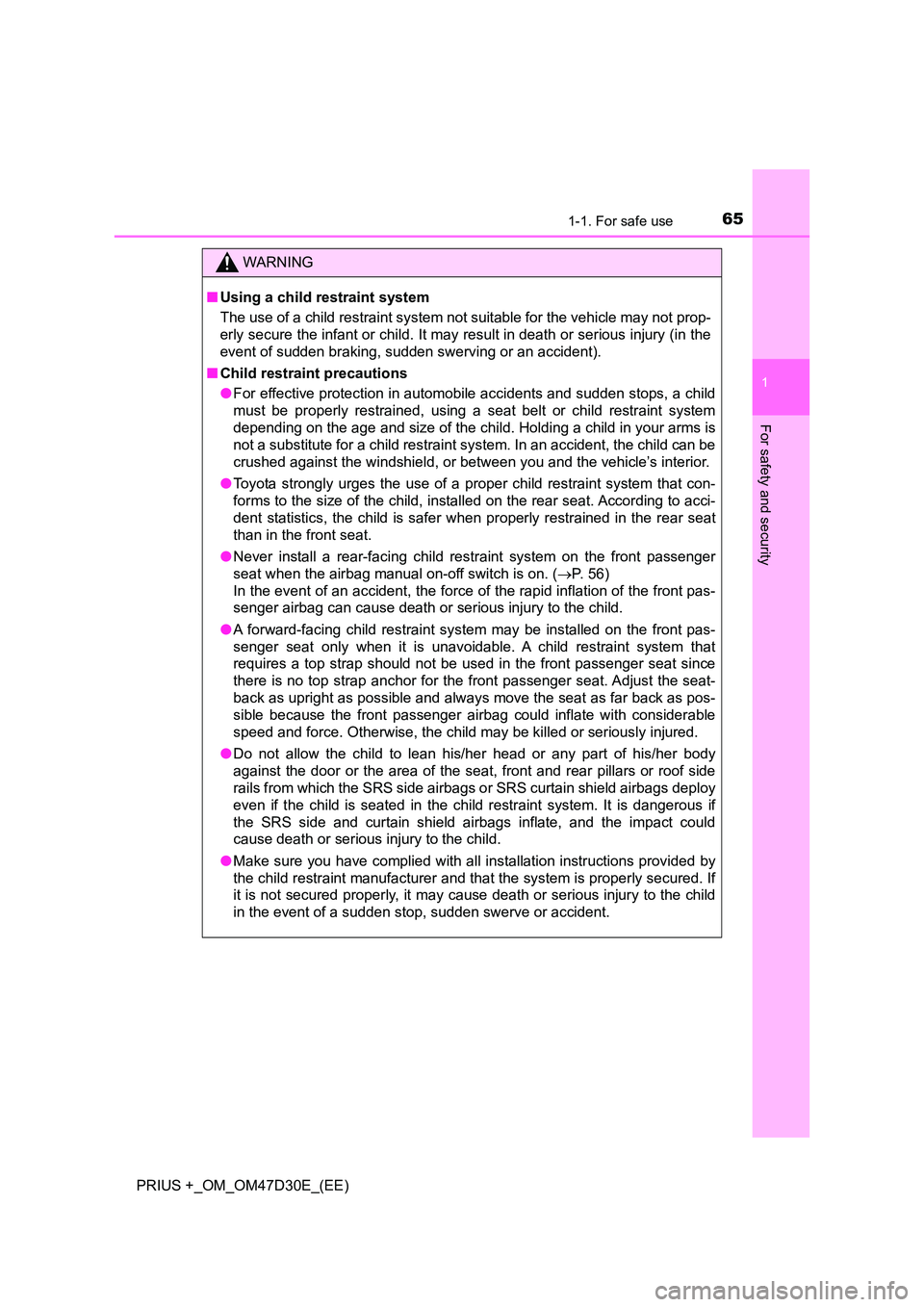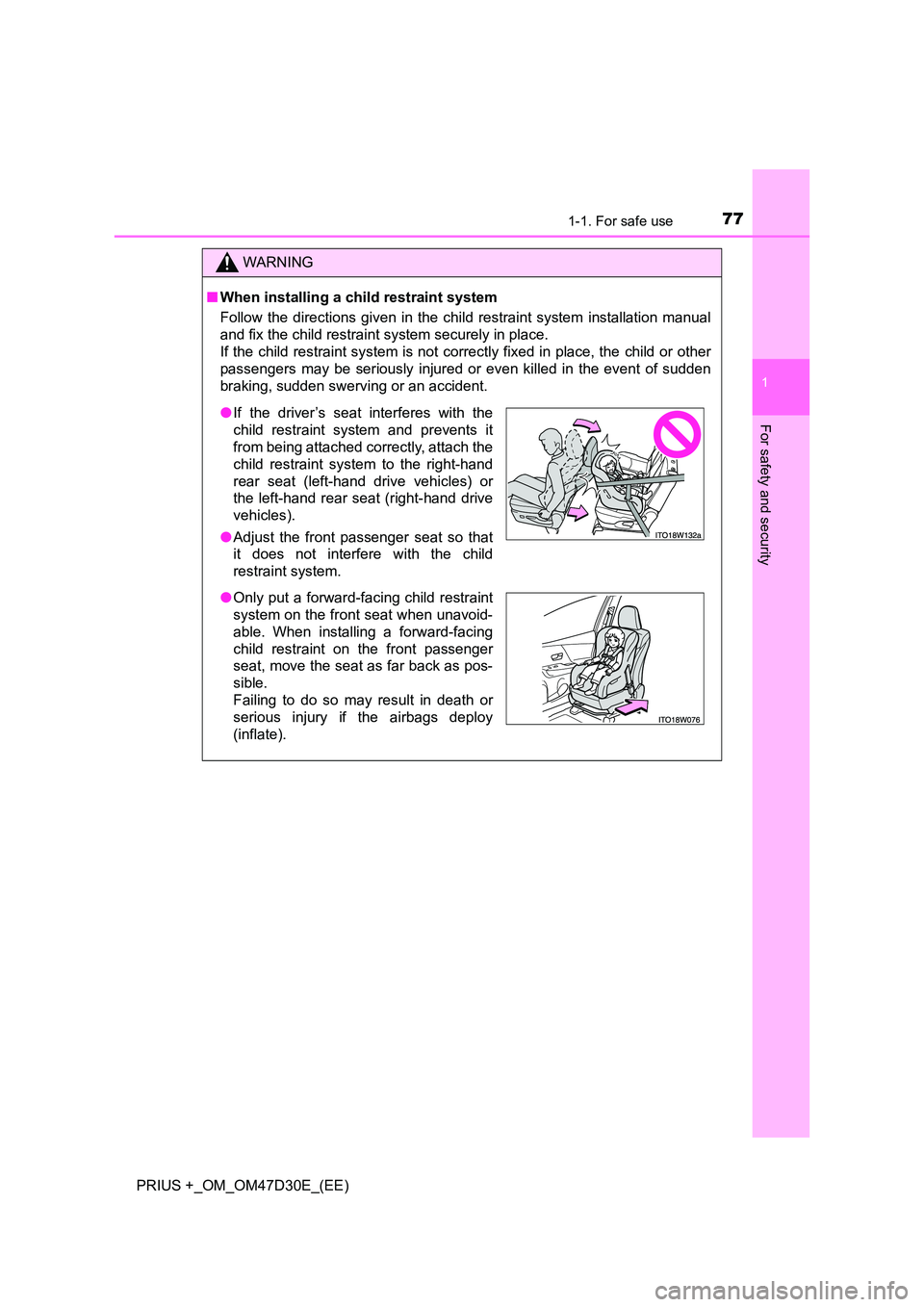Page 54 of 568
541-1. For safe use
PRIUS +_OM_OM47D30E_(EE)
The SRS side and curtain shield airbags do not generally inflate if the vehicle
is involved in a rear collision, if it rolls over, or if it is involved in a low-speed
side or low-speed frontal collision.
■ When to contact any authorized Toyota retailer or Toyota authorized
repairer, or any reliable repairer
In the following cases, the vehicle will require inspection and/or repair. Con-
tact any authorized Toyota retailer or Toyota authorized repairer, or any reli-
able repairer as soon as possible.
● Any of the SRS airbags have been inflated.
● Collision from the rear
● Vehicle rollover
● The front of the vehicle is damaged or
deformed, or was involved in an acci-
dent that was not severe enough to
cause the SRS front airbags to inflate.
Page 55 of 568
551-1. For safe use
1
PRIUS +_OM_OM47D30E_(EE)
For safety and security
●A portion of a door or its surrounding
area is damaged or deformed, or the
vehicle was involved in an accident that
was not severe enough to cause the
SRS side and curtain shield airbags to
inflate.
● The pad section of the steering wheel,
dashboard near the front passenger air-
bag or lower portion of the driver’s side
instrument panel is scratched, cracked,
or otherwise damaged.
● The surface of the seats with the side
airbag is scratched, cracked, or other-
wise damaged.
● The portion of the front pillars, rear pil-
lars or roof side rail garnishes (padding)
containing the curtain shield airbags
inside is scratched, cracked, or other-
wise damaged.
Page 56 of 568
561-1. For safe use
PRIUS +_OM_OM47D30E_(EE)
Airbag manual on-off system
“PASSENGER AIR BAG” indi-
cator
The ON indicator light turns on
when the airbag system is on (only
when the power switch is in ON
mode).
Airbag manual on-off switch
This system deactivates the front passenger airbag, front pas-
senger knee airbag and front passenger side airbag.
Only deactivate the airbags when using a child restraint system
on the front passenger seat.
1
2
Page 57 of 568

571-1. For safe use
1
PRIUS +_OM_OM47D30E_(EE)
For safety and security
Insert the mechanical key into the
cylinder and rotate to the OFF
position.
The OFF indicator light turns on
(only when the power switch is in
ON mode).
■ “PASSENGER AIR BAG” indicator information
If any of the following problems occur, it is possible that there is a malfunction
in the system. Have the vehicle inspected by any authorized Toyota retailer or
Toyota authorized repairer, or any reliable repairer.
● Neither ON nor OFF comes on.
● The indicator light does not change when the airbag manual on-off switch is
switched to ON or OFF.
Deactivating the airbags for the front passenger
WARNING
■ When installing a child restraint system
For safety reasons, always install the child restraint system in a rear seat. In
the event that the rear seat cannot be used, the front seat can be used as
long as the airbag manual on-off system is set to OFF.
If the airbag manual on-off system is left on, the strong impact of the airbag
deployment (inflation) may cause serious injury or even death.
■ When a child restraint system is not installed on the front passenger
seat
Ensure that the airbag manual on-off system is set to ON.
If it is left off, the airbag may not deploy in the event of an accident, which
may result in serious injury or even death.
Page 61 of 568
611-1. For safe use
1
PRIUS +_OM_OM47D30E_(EE)
For safety and security
Information provided in the table shows your child restraint system
suitability for various seating positions.
Child restraint system suitability for various seating positions
Front passenger seat
Second seatThird seatAirbag manual
on-off switch
ONOFFOutsideCenter
0
Up to 10 kg
(22 lb.)
(0 - 9 months)
X
Never put
U
L1
U
L1
U
L1
U
L1
0+
Up to 13 kg
(28 lb.)
(0 - 2 years)
X
Never put
U
L1
U*1
L1
U
L1
U
L1
I
9 to 18 kg
(20 to 39 lb.)
(9 months -
4 years)
Rear-
facing —
X
Never put UUUU
Forward-
facing —
UF
II, III
15 to 36 kg
(34 to 79 lb.)
(4 - 12 years)
UF U U
L2*2UU
Seating
position
Mass groups
Page 65 of 568

651-1. For safe use
1
PRIUS +_OM_OM47D30E_(EE)
For safety and security
WARNING
■Using a child restraint system
The use of a child restraint system not suitable for the vehicle may not prop-
erly secure the infant or child. It may result in death or serious injury (in the
event of sudden braking, sudden swerving or an accident).
■ Child restraint precautions
● For effective protection in automobile accidents and sudden stops, a child
must be properly restrained, using a seat belt or child restraint system
depending on the age and size of the child. Holding a child in your arms is
not a substitute for a child restraint system. In an accident, the child can be
crushed against the windshield, or between you and the vehicle’s interior.
● Toyota strongly urges the use of a proper child restraint system that con-
forms to the size of the child, installed on the rear seat. According to acci-
dent statistics, the child is safer w hen properly restrained in the rear seat
than in the front seat.
● Never install a rear-facing child restraint system on the front passenger
seat when the airbag manual on-off switch is on. ( P. 5 6 )
In the event of an accident, the force of the rapid inflation of the front pas-
senger airbag can cause death or serious injury to the child.
● A forward-facing child restraint system may be installed on the front pas-
senger seat only when it is unavoidable. A child restraint system that
requires a top strap should not be used in the front passenger seat since
there is no top strap anchor for the front passenger seat. Adjust the seat-
back as upright as possible and always move the seat as far back as pos-
sible because the front passenger airbag could inflate with considerable
speed and force. Otherwise, the child may be killed or seriously injured.
● Do not allow the child to lean his/her head or any part of his/her body
against the door or the area of the sea t, front and rear pillars or roof side
rails from which the SRS side airbags or SRS curtain shield airbags deploy
even if the child is seated in the child restraint system. It is dangerous if
the SRS side and curtain shield airbags inflate, and the impact could
cause death or serious injury to the child.
● Make sure you have complied with all installation instructions provided by
the child restraint manufacturer and that the system is properly secured. If
it is not secured properly, it may cause death or serious injury to the child
in the event of a sudden stop, sudden swerve or accident.
Page 77 of 568

771-1. For safe use
1
PRIUS +_OM_OM47D30E_(EE)
For safety and security
WARNING
■When installing a child restraint system
Follow the directions given in the child restraint system installation manual
and fix the child restraint system securely in place.
If the child restraint system is not correctly fixed in place, the child or other
passengers may be seriously injured or even killed in the event of sudden
braking, sudden swerving or an accident.
● If the driver’s seat interferes with the
child restraint system and prevents it
from being attached correctly, attach the
child restraint system to the right-hand
rear seat (left-hand drive vehicles) or
the left-hand rear seat (right-hand drive
vehicles).
● Adjust the front passenger seat so that
it does not interfere with the child
restraint system.
● Only put a forward-facing child restraint
system on the front seat when unavoid-
able. When installing a forward-facing
child restraint on the front passenger
seat, move the seat as far back as pos-
sible.
Failing to do so may result in death or
serious injury if the airbags deploy
(inflate).
Page 78 of 568
781-1. For safe use
PRIUS +_OM_OM47D30E_(EE)
WARNING
■When installing a child restraint system
●Never use a rear-facing child restraint
system on the front passenger seat
when the airbag manual on-off switch is
on. ( P. 56)
The force of the rapid inflation of the
front passenger airbag can cause
death or serious injury to children in the
event of an accident.
● There is a label(s) on the passenger
side sun visor, indicating it is forbidden
to attach a rear-facing child restraint
system to the front passenger seat.
Details of the label(s) are shown in the
illustration below.